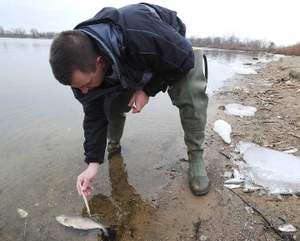
Cathy Pedlar and Kathryn Hamilton were walking by Presque Isle State Park's Misery Bay on Tuesday afternoon when they spotted thousands of dead fish along the north shore.
Pedlar said she's seen dead fish before, but never like this.
"I haven't seen this density before," she said.
Park and state officials were notified and a Pennsylvania Department of Environmental Protection official investigated.
"This is a natural fish kill, no cause for alarm," Jim Grazio, a Great Lakes biologist with DEP's Office of the Great Lakes, said after inspecting the dead fish.
He said 99 percent were gizzard shad and he believed their death was a natural event caused by temperature change.
Grazio said the gizzard shad, a freshwater herring, is notoriously sensitive to cold temperatures and temperature changes.
He also said more than the usual number of the fish were born in 2010 for unknown reasons.
"A lot of them didn't survive," he said.
The fish began dying in January and were under the ice, unseen until warmer temperatures caused a melt and the fish began washing up on shore, he said. There wasn't much decay because of the cold.
Gizzard shad, which aren't typically eaten by people, form the base of the food chain for other fish, like lake trout, steelhead and walleye, Grazio said. But because of the large number of gizzard shad born in 2010, the kill won't cause other fish to go hungry this year, he said.
Grazio said the fish kill isn't isolated to this area and dead gizzard shad have been reported all around the Great Lakes basin.
A few other species of fish also were discovered Tuesday among the dead, along with a duck that could have died anytime and just been revealed by the melt.
Grazio said he saw about half a dozen northern pike, mostly large females.
"More than likely their death was related to spawning stress," he said.
However, Grazio did urge people to prevent pets from eating any dead fish they find as a way to prevent potential disease transmission.



That the officials all claim "No cause for alarm" on all of these numerous events.
And then this "The fish began dying in January and were under the ice, unseen until warmer temperatures caused a melt and the fish began washing up on shore, he said. There wasn't much decay because of the cold."
Yet only 7 days prior and approximately 100 miles upstream we see this "Ontario Power Generation has notified Canada's federal nuclear regulator about the release of 73,000 litres of demineralized water into Lake Ontario at the Pickering A nuclear generating station. The leak occurred at 11:30 p.m. ET on Monday at the plant located about 35 kilometres east of Toronto and was caused by a pump seal failure."
So we are to believe that these fish have been dead due to cold and not decayed due to cold for nearly 3 months?
One has to ask "Isn't it always cold in these northern waters in the winter?" "And how come we don't see massive fish kills every winter?"
Ultimate in doublespeak... "We're all going to die from global warming, if we don't freeze to death first. While at the same time saying "No cause for alarm, all is normal."
Obviously the only way to save humanity is through a global carbon tax and trade system..... barf